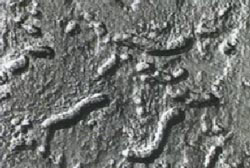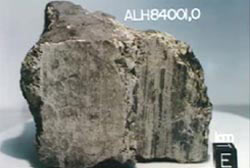|
Does a meteorite found in the Antarctic hold evidence of life on Mars?  Is there life on Mars?  Fossils were found on the rock CASE DETAILS Deep Space is the last great frontier. Each new image captured by telescopes brings up the age-old question: Is there life somewhere else in the universe?  A piece of a meteorite from Mars Some imagined the answer would come from a spaceship carrying aliens from a faraway civilization. But, in fact, the truth might be hidden in this ordinary-looking piece of meteorite known as Rock #84-001. It came from the planet Mars and traveled millions of miles over millions of years until it slammed into Earth. Richard Berendzen, professor of astronomy at American University, says it may forever change the way we view the universe:
Kathie Thomas-Keprta is a planetary geologist with Lockheed Martin;
 The Pathfinder will collect samples from Mars Some scientists theorized that the seeds for life on Earth were planted by microorganisms from Mars. Ironically, what may prove to be the most remarkable discovery in the history of mankind began with a completely unremarkable event. In December of 1984, Dr. Robert Score was among a team of American scientists on a geological expedition searching for meteorites in Antarctica. Dr. Score picked up the rock now known as #84-001. It weighed only 4.2 pounds and was the size of a large potato. No one paid much attention to it. For eight years, it sat on a shelf gathering dust. Donald W. Goldsmith is the author of “The Hunt For Life On Mars”:
As it turned out, 84-001 was only the 12th Martian meteorite ever found. It is 4.5 billion years old, almost as old as our solar system, and existed at least one billion years before life on Earth began. A team of NASA scientists finally analyzed the rock. Deep within, were what appeared to be signs of life: the fossilized remains of dozens of incredibly tiny microorganisms. Dr. Everett K. Gibson is senior planetary scientist with NASA:
For a scientist, “a trail of evidence” is like a map to buried treasure. However, this map goes back in time as well as taking us to a different place. It suggests a remarkable journey that began on Mars, four and a half billion years ago, when our solar system was just taking shape. At the same time that #84-001 was being formed, Mars was being bombarded by a catastrophic meteor storm. Its surface was left covered with craters and crevices. Dr. Everett K. Gibson:
Over the next 500 million years, chemical reactions in this “primeval soup” apparently produced a primitive life form. As the water evaporated, the microscopic life forms were enclosed in rock and became fossilized. According to Everett Gibson, one such rock may have been #84-001:
While the organisms in #84-001 were fossilized, it’s quite possible that other meteorites carried living organisms all the way to Earth. These organisms could have been the source of all life on our planet. Author Donald Goldsmith says that the origin of the human race may, in fact, be Mars:
The possibilities are enough to excite even the most skeptical scientist. But they warn that #84-001 is not definitive proof of life on Mars. Richard Berendzen says a follow up mission is needed:
On December 4th, 1996, the unmanned Pathfinder spacecraft took off for Mars. During its nine month visit to the “Red Planet”, Pathfinder collected more than 17,000 images and performed more than a dozen chemical studies of rocks, soil and weather data. But to look for signs of life, says David McKay, we’ll have to dig:
Geologist Dr. Robert C. Anderson with JPL:
NASA scientist Everett Gibson:
During its Phoenix Mission in 2008, NASA landed a robotic spacecraft on the surface of the planet and tested for traces of water in the soil and atmosphere. Scientists still hope to get one step closer to answering the age-old question: Are we alone or is there any other life out there? Watch this case now on Amazon Prime in season five with Dennis Farina. Also available on YouTube with Dennis Farina. Various seasons available now on Hulu. |
Anonymous
I wish we could make a flying saucer out of rocks and dirt. That would be cool. Unfortunately you need factories to make drones like that. Humans are in my opinion the only ones capable.
lasagne
its ok kyle
kyle
I hate my life
chanita
did you know that mars is also called the red planet and yes I do really believe there is life on mars metorites are very dangerous!